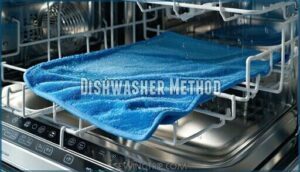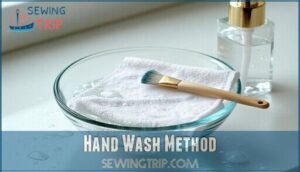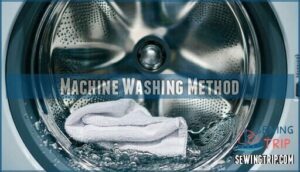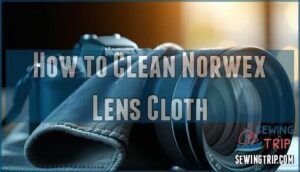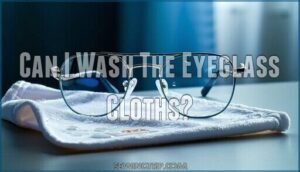This site is supported by our readers. We may earn a commission, at no cost to you, if you purchase through links.
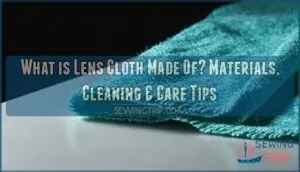 Lens cloths are made from tightly woven synthetic fibers, primarily microfiber—a blend of polyester and polyamide that’s split into ultra-fine strands.
Lens cloths are made from tightly woven synthetic fibers, primarily microfiber—a blend of polyester and polyamide that’s split into ultra-fine strands.
This construction creates millions of microscopic hooks that trap dust and oils without scratching delicate surfaces.
You’ll also find some cloths made from cotton flannel or chamois leather, though microfiber remains the gold standard.
The secret sauce isn’t just what lens cloths are made of, but how these materials work together—the polyester attracts dirt while polyamide absorbs moisture.
Quality lens cloths feel smooth yet grippy, like velvet with attitude.
Understanding your cloth’s material helps you care for it properly and maximize its cleaning power.
Table Of Contents
- Key Takeaways
- Lens Cleaning Cloth Materials
- Are Lens Cleaning Cloths Lint-Free?
- Do Microfiber Cloths Scratch Eyeglasses?
- How to Clean Microfiber Cloth for Glasses
- Can You Wash Crizal Lens Cloth?
- How to Clean Norwex Lens Cloth
- Where to Buy Microfiber Lens Cloth
- What Are Eyeglass Cloths?
- Can I Wash The Eyeglass Cloths?
- Frequently Asked Questions (FAQs)
- Conclusion
Key Takeaways
- Microfiber construction: Your lens cloth is made from microfiber—an 80% polyester and 20% polyamide blend that’s 100 times thinner than human hair, creating millions of microscopic hooks to trap dirt without scratching.
- Superior cleaning power: The split-fiber construction increases surface area and absorbency, allowing your cloth to lift oils and particles instead of pushing them around your delicate lens coatings.
- Scratch-safe design: Unlike cotton or paper towels that act like sandpaper, microfiber’s ultra-fine synthetic fibers won’t damage your eyeglasses, screens, or anti-reflective coatings when used properly.
- Washable and reusable: You can clean your lens cloth using machine washing, hand washing, dishwasher, or microwave methods—just skip fabric softeners and air dry to maintain its effectiveness for months.
Lens Cleaning Cloth Materials
Everyone needs a reliable microfiber cloth to keep their lenses spotless.
These optical cleaning cloths aren’t just any fabric—they’re engineered from specific synthetic fibers that make all the difference.
A quality microfiber lens cloth contains precise fabric blends of polyester and polyamide (nylon).
The ideal microfiber composition is 80% polyester content and 20% polyamide, creating the perfect balance for lens care.
This combination reduces loose fibers while enhancing oil absorption.
What makes these soft microfiber cloths special is their fiber thickness.
Each microfiber is 100 times thinner than human hair, with about 90,000 synthetic fibers packed into every square inch.
These ultra-fine strands create a gentle yet effective cleaning surface.
The split-fiber construction in quality microfiber lens cloths increases surface area and absorbency.
This unique structure allows the cloth to trap dirt particles and oils without pushing them around your lenses.
Some manufacturers now offer 100% recycled polyester options for environmentally conscious users.
Choose authentic microfiber cloth products over cotton alternatives—your lenses deserve proper care.
Are Lens Cleaning Cloths Lint-Free?
How can you be sure your lens cleaning cloth is truly lint free? It comes down to the microfiber quality and fiber structure.
Lintfree microfiber cloths are designed with a tightly woven pattern that traps dust and oils, leaving nothing behind.
Here’s what to look for:
- Check for a tight, durable weave—this boosts cloth durability and prevents lint.
- Choose high-quality microfiber lens cleaning cloths from trusted brands.
- Wash your lens cloth separately to maintain its cleaning efficiency.
- Avoid fabric softeners; they clog fibers and reduce effectiveness.
- Replace your microfiber cloth if it starts shedding or feels rough.
A good microfiber lens cloth keeps your glasses and screens crystal clear—no stray fibers, no fuss. For ideal results, consider using lint free products to clean your lenses effectively.
Do Microfiber Cloths Scratch Eyeglasses?
In the context of scratch resistance, you can trust microfiber cloths completely. These specialized cleaning tools won’t damage your eyeglasses, making them the gold standard for lens safety.
Microfiber quality matters because the ultra-fine synthetic fibers are 100 times thinner than human hair. This construction creates a gentle surface that lifts dirt and oils without abrading your lenses. Unlike paper towels or cotton fabrics that can act like sandpaper on delicate coatings, microfiber cloth glides smoothly across surfaces.
Here’s what makes microfiber so effective for eyeglass care:
- The tight weave traps particles instead of dragging them across your lenses
- Split fibers create millions of microscopic pockets that grab contaminants safely
- Non-abrasive material protects anti-reflective and other specialized coatings
For proper lens cleaning, use gentle circular motions. This technique prevents scratches while removing smudges effectively. Your eyeglasses deserve this level of protection, especially considering replacement costs. Smart cleaning methods start with choosing the right tool.
How to Clean Microfiber Cloth for Glasses
Proper cleaning keeps your microfiber lens cloth effective and prevents scratching your glasses. You can clean your cloth using four simple methods: microwave, dishwasher, hand washing, or machine washing.
Microwave Method
The microwave method offers a quick sanitizing solution for your microfiber cloth. Simply dampen the cloth, wring out excess water, and microwave on high for 60 seconds.
This heating time kills bacteria without harsh detergents. The hot temperature sterilizes accumulated dirt and germs effectively. However, excessive heat can melt synthetic fibers, so moderation is key.
| Microwave Safety | Best Practice |
|---|---|
| Heating Time | 60 seconds maximum |
| Temperature Control | High setting only |
| Moisture Level | Damp, not soaking |
| Fiber Damage Prevention | Never overheat |
This cleaning method maintains your lens cleaning cloth’s reusability while boosting cleaning efficiency. The microwave approach works well for quick sanitization between deeper cleaning sessions, keeping your microfiber cloth fresh and ready for streak-free lens cleaning.
Regular eye care checks are essential for overall eye health and maintaining clean lenses.
Dishwasher Method
Your dishwasher can handle this task with machine washable microfiber cloth care. Place the lens cleaning cloth on the top rack and select a gentle cleaning cycle for ideal microfiber care.
This dishwasher safety approach prevents melting while the hot water dissolves oils effectively. Skip fabric softener to maintain fabric protection, then air-dry using proper drying methods.
Using Dishwasher Safe materials is vital for the longevity of your microfiber cloths.
- Top rack placement – prevents heat damage to delicate microfiber
- Gentle cycle selection – protects fabric integrity during washing
- No fabric softener – avoids residue buildup on microfiber
- Air-dry only – preserves microfiber structure and cleaning power
- Post-wash inspection – check for any heat-related damage
Hand Wash Method
Hand washing your microfiber lens cloth requires a gentle touch to preserve those delicate fibers.
Start by running cold water over the cloth, letting dirt naturally loosen without aggressive scrubbing. Add a small drop of gentle soap for stubborn oils and fingerprints.
Use a soft brush if needed, working in light circular motions. Rinse thoroughly under cold water until soap residue disappears.
Proper fabric care means air drying your soft microfiber cloth completely before storage. This washing method keeps your microfiber lens cloth performing like new.
Regular cleaning with a microfiber lens cloth is essential for maintaining optical clarity.
Machine Washing Method
When you’re machine washing your microfiber lens cloth, toss it in alone—no need to invite linty towels to the party.
Stick with cold water and a gentle cycle for exceptional microfiber care. Choose a mild, bleach-free detergent; harsh cleaners can break down those tiny fibers.
Skip the fabric softener, too—it clogs the cloth and ruins its cleaning power. Line dry your lens cleaning cloth, since high heat can melt or warp the material.
Most microfiber cloths are machine washable, but check care instructions for premium brands. Following these washing tips helps your cloth last longer and keeps your glasses streak-free.
Simple steps, crystal-clear results. Regular microfiber cloth wash methods are essential for maintaining the cloth’s effectiveness.
Can You Wash Crizal Lens Cloth?
You can wash your Crizal lens cleaning cloth without worry. The manufacturer recommends machine washing on a gentle cycle for ideal Crizal Care. This microfiber cloth thrives with regular cleaning—studies show washing actually improves cleaning performance by 17%.
Your machine washable Crizal cloth contains specially woven polyester and polyamide fibers designed for Microfiber Durability. These smooth fibers maintain their Fabric Softness while effectively trapping dirt and oils during Lens Maintenance.
Use mild, bleach-free Cleaning Solutions and skip fabric softeners, which can damage the microfiber’s structure. The washing process restores the cloth’s electrostatic charge, helping it attract dust particles more effectively.
Air dry or tumble dry on low heat to preserve the microfiber care properties. Check your lens cleaning cloth regularly—when it looks grimy or stops performing well, it’s time for a wash. Proper Microfiber Care keeps your Crizal cloth working like new.
How to Clean Norwex Lens Cloth
Norwex lens cloths require specific care to maintain their microfiber effectiveness. These specialized cloths handle daily cleaning tasks well, but periodic deep cleaning keeps them performing at their best.
Start your Norwex care routine by machine washing the cloth before first use. For regular maintenance, hand wash with warm water and gentle detergent. Rinse thoroughly to remove all soap residue, which can leave streaks on your lenses.
Air dry or use low heat in your dryer. Skip fabric softeners and dryer sheets – they’ll coat the microfibers and reduce cleaning power.
For deeper cleaning, soak heavily soiled cloths in warm water with eco-friendly detergent. This microfiber washing technique loosens stubborn oils and grime without damaging the delicate fibers.
Here’s your lens maintenance checklist:
- Wash weekly with liquid detergent only
- Use warm water, never hot
- Air dry to preserve fiber durability
- Store in clean, dry areas
- Replace when fraying occurs
Proper cloth sanitizing extends your Norwex’s lifespan substantially. With consistent cleaning microfiber cloth care, you’ll maintain streak-free lens cleaning performance for years. Regular maintenance involves understanding proper cleaning methods to keep your lens cloth in good condition.
Where to Buy Microfiber Lens Cloth
Restoring your lens cloth’s cleaning power is only half the battle—you’ll want extras on hand. For peace of mind, buy microfiber cloths from trusted sources.
Online Retailers like Amazon, Walmart, and Target offer a wide range of lens cleaning cloths. Camera Stores and Electronic Shops carry high-quality options, but prices can be steeper.
Bulk Purchases through eBay Sellers can save you money, especially if you clean glasses often. Don’t be tempted by fake logos or knockoffs; they may scratch your lenses.
Always check reviews and stick with brands recommended by eye care professionals. Here’s a quick guide:
| Where to Buy | What to Expect |
|---|---|
| Online Retailers | Convenience, variety |
| Camera/Electronic Shops | Quality, expert advice |
What Are Eyeglass Cloths?
If you wear glasses, you know how quickly lenses pick up fingerprints and smudges.
That’s where an eyeglasses cloth steps in. Unlike a soft cotton cloth or your shirt, a lens cleaning cloth made from microfiber is designed for Lens Care.
The Microfiber Benefits are clear: ultrafine Fiber Types trap dust and oils without scratching delicate coatings. A quality microfiber cloth is gentle, lint-free, and tough enough for daily use—talk about Cloth Durability.
Some come in stylish patterns, others in basic packs, but all help keep your Eye Glass surfaces clear. Choose eyeglasses cloth from trusted optical shops to avoid cheap imitations. Microfiber is the safest bet for your lenses.
Can I Wash The Eyeglass Cloths?
Eyeglass owners know that a clean lens cleaning cloth is half the battle in keeping your vision sharp.
You can—and should—wash your microfiber cloth regularly.
Washing Methods like hand washing or gentle machine cycles keep those tiny fibers working hard.
For Fiber Care, skip the fabric softener and bleach; they can clog the cloth and reduce cleaning power.
Aim for Cleaning Frequency of at least once a month, or more if you use your lens cleaning cloth daily.
Cloth Durability is solid—good microfiber cloths last through many washes.
After cleaning, air dry to prevent heat damage.
Store your lens cloth in a clean, dry pouch to keep it dust-free.
Proper Storage Tips and regular washing help your lens cloth stay effective and long-lasting.
Frequently Asked Questions (FAQs)
What are lens cloths made of?
Microfibers contain 90,000 fibers per square inch.
You’ll find lens cloths made from microfiber fabric—typically 80% polyester and 20% polyamide blends.
These synthetic materials create non-abrasive surfaces that won’t scratch your delicate lenses.
What can I use instead of a lens cloth?
You can’t really substitute lens cloths effectively.
Cotton swabs, tissues, shirttails, or sleeves will scratch your lenses.
These materials lack microfiber’s non-abrasive properties and can cause costly damage that’s impossible to repair.
Is a lens cloth microfiber?
Yes, lens cloths are typically made from microfiber.
You’ll find they’re composed of polyester and polyamide blends with ultra-fine synthetic fibers that effectively clean without scratching your lenses or leaving lint behind, making them a great tool for cleaning with care.
Can I keep using the cloth that comes with my glasses?
No need to reinvent the wheel—keep using the cloth that comes with your glasses.
Just wash it regularly, skip the fabric softener, and store it in a clean pouch.
That way, your lenses stay spotless and scratch-free.
How often should I replace my lens cloth?
Replace your lens cloth every 3-6 months with regular use, or when it becomes heavily soiled despite washing. High-quality microfiber cloths last longer but eventually lose effectiveness through wear.
Can lens cloths damage anti-reflective coatings?
Quality microfiber lens cloths won’t harm anti-reflective coatings when used properly.
However, dirty cloths can trap particles that scratch delicate coatings.
Clean your cloth regularly and use gentle circular motions to protect your investment.
Whats the difference between suede and microfiber cloths?
Microfiber cloths use synthetic polyester-polyamide blends with split fibers for superior cleaning.
Suede cloths offer softer texture but microfiber’s lint-free properties and oil absorption make it the industry standard for lens cleaning.
Are all microfiber lens cloths the same quality?
No, microfiber lens cloths vary in quality.
You’ll find differences in fiber density, blend ratios, and construction.
The best cloths use 80% polyester and 20% polyamide with tighter weaves for superior cleaning performance.
Can I use lens cloths on phone screens?
Yes, you can safely use lens cloths on phone screens. These microfiber cloths won’t scratch your display and effectively remove fingerprints, smudges, and oils without leaving streaks or residue behind.
Conclusion
Let’s face it—if you’re still using your shirt to clean your glasses, you’re living dangerously.
Now you know exactly what lens cloth is made of and why microfiber is the go-to choice.
These cloths trap dirt, avoid scratches, and keep your lenses crystal clear. Treat them right with proper washing and storage.
Next time you reach for a lens cloth, you’ll know you’re making the smart, safe choice for your eyewear.
- https://en.wikipedia.org/wiki/Microfiber
- https://www.koalaeye.com/blogs/our-stories/can-old-eyeglasses-be-donated
- https://oculuseyecare.com/blogs/news/how-to-wash-microfiber-cloth-for-glasses?srsltid=AfmBOopW-wV_NA0z4pN4suVfika4saMXE1ImmouNq-X5jfXRvFoX7P0J
- https://www.vintandyork.com/blogs/content/how-to-clean-an-eyeglass-cleaning-cloth
- https://www.arthurhayes.co.uk/expert-eye-care-blog/how-to-clean-microfibre-lens-cloth?srsltid=AfmBOooJ-Hu8rMcghlSIBbXhoIppbLixDbq0u5rEmOU2a_nVY0032e3w



